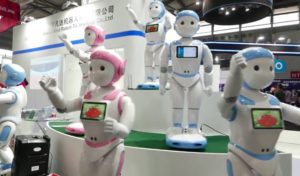Asia’s own version of the Consumer Electronic Show (CES Asia 2017) took place earlier this month in Shanghai. The show was an excellent opportunity to see the latest trends and examine the technologies which are disrupting the industry. But what were the key lessons and takeaways from the three-day event?
- The Consumer Electronics market is an IoT Consumer market
You may think this is just a play on words, but the obvious occasionally needs to be pointed out. Only a few years ago, consumer electronics were not necessarily connected. At CES Asia this year, almost everything was connected to smartphones or to the Cloud for an even smarter, richer experience. Unconnected devices are far rarer now.
The smartphone is now the remote controller of your array of connected devices, from connected ball throwers for dogs, to smartwatches and to fitness wearables. There is also more value than ever before in the Cloud. The challenge now however is the fragmentation of the experiences; will we see a player able to offer a unified user experience whatever the device, whatever the environment? Time will tell.
2. The Things are smarter
Things are smarter not only because they are connected to the Cloud but also because they possess powerful onboard microprocessors. The latest smartphones, tablets, or cars provide a good demonstration of this ever-increasing capacity, paving the way for the development of artificial intelligence and machine learning. The opening keynote of Huawei’s COO Wan Biao launched several ever more powerful consumer devices, including the Huawei MateBook range and the latest version of Huawei’s M3 Android tablet.
Furthermore, the vision of Microsoft by Peter HAN, VP Partner Devices and Solutions, Microsoft and Rodney CLARK, VP IoT Device Experience is directly connected to reality: “an intelligent edge connected to the intelligent cloud”. The edge is composed of multi-devices and multi-sensors filling up the Cloud. It’s clear Microsoft is investing heavily in machine learning, analytics and big data to make the experience smarter: “modern devices for modern experiences”.
3. Living in an open world of unmanned “vehicles”
The most popular unmanned vehicles at CES were the drones. DJI, the leading manufacturer, has revolutionized the experience with ever smaller and more ergonomic models; the drones are now connected to the smartphone for smart piloting. However, the competition is incredibly dynamic and fierce with a large number of challengers. The best innovations may come from a variety of use cases that go beyond just entertainment; demonstrations of parcels delivery with UPS were most impressive. Delayed deliveries due to traffic jams could become a thing of the past. The drones were everywhere, in the sky but also under the water as we saw from Power Vision with their underwater drone (or perhaps we can call it an unmanned submarine?).

Even more surprising was the “autonomous” suitcase from Cowarobot, following you (or more precisely your smartphone) in the airport or train station. It’s also impossible to discuss unmanned vehicles without referencing the world of the autonomous cars. An entire hall at the show was dedicated to the automotive sector. The leaders in the industry demonstrated how the cars of the future are becoming smarter and more autonomous. The most spectacular, confirmed by the large number of people attending the presentation, was the prototype of NEVS, disrupting the basic concept of a car. NEVS proposes an electrical and autonomous concept able to transform in an office or gaming room. The overall idea is to contribute to a better life.
4. Devices for a better life
The positive objectives of NEVS are shared by many device makers as we saw at the show. At every turn, the customer experience was at the heart of the experience. This is very much the case for the wearables that monitor our wellness, with health tracking and more and more coaching applications. The smart sportswatch is now seemingly mandatory for a performance running session, but also for other sports (golf, swimming…) as demonstrated by Garmin.
Huawei’s own sports watch which features embed cellular connectivity that allows you to receive a call on the go was also an enjoyable attraction. More surprising is the new life experience proposed by Mercedes with Mercedes me Fit & Healthy. The German manufacturer has designed their cars as a central health hub, working in unison with smart devices in the home and with wearables to generate a more holistic picture of a user’s vital data. It might not be long until we see a lesser need for doctors.
- The retail experience at the beginning of a new era
Virtual Reality allows for the opportunity of an immersive customer experience such as previewing your future holiday before flying. The shopping experience is becoming increasingly personalized and fully interactive. Directly connected to your preferences in the Cloud, brands will offer you a personalized shopping experience. HaoMaiYi, a fashion company that provides branded clothing style to all ages, demonstrated the interactive shop with an interactive experience. We are indeed witnessing the dawn of a new era. It might not be long until our shopping experiences become as personalized as they are in Minority Report.
We must however also bear in mind how the customer journey of the end-user will dramatically change if all these new experiences become successful. The main hurdle that remains is perfecting the customer experience, both in terms of realizing the benefits of the service proposed but also safeguarding the trust relied on by customers to share their personal preferences with service providers. Ultimately, the customer experience will always be crucial and will outrank all other factors though. The show made this point more than clear, and reminded us of the findings of our most recent Connected Living and Future Customer Experience surveys.
What do you think of the five lessons we’ve highlighted from the show? Let us know by commenting below, or tweet to us @Gemalto.




